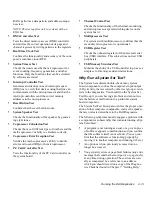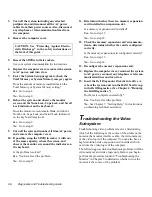
4-22
Diagnostics and Troubleshooting Guide
•
Interrupt Test
Checks to see if the audio controller is generating an
interrupt on the IRQ line configured for that
controller
•
DMA Test
Tests for the presence of a DMA channel on the sys-
tem chip set, and determines if the DMA controller
and audio controller can exchange signals
•
FIFO RAM Test
Checks the read/write capabilities and status of the
audio controller
•
Initial Reset Status Test
Verifies the reset values of the extended registers on
the audio controller
•
Internal Register Test
Writes test patterns to the internal registers of the
audio controller, then reads other registers to confirm
that the patterns are correctly interpreted
•
Dual Channel Test
Confirms the presence of a second DMA channel on
the system chip set and determines if the DMA con-
troller and audio controller can exchange signals on
that second DMA channel
•
FM Sound Playback Test
Tests whether the system can synthesize sounds and
play them through the built-in speakers
•
Analog Sound Playback Test
Tests whether the system can play sampled sounds
through the built-in speakers
•
Record and Playback Test
Checks the ability of the audio controller to generate
a sampled sound from signals received from the
built-in microphone
Why Run an Audio Test?
If you do not hear sounds from your built-in speakers when
you expect to, it is possible that your operating system or
sound application uses resource settings different from
those of the audio controller in the computer. In the absence
of an expected sound, first check the documentation that
accompanied your operating system or sound application to
see if the sound features are correctly configured to work
with the computer. The default settings for the audio con-
troller are:
•
DMA channel: 1
•
IRQ line: 5
•
Port address: 220h
If necessary, change the resource settings in your operat-
ing system or sound application to match these default
settings.
If you still do not hear sound when you expect to, run the
Audio Test Group.
NOTE: Before running the Audio Test group, make sure
to enable the built-in speaker(s), and make sure that the
speaker volume has not been muted.
O
ther Test Group
The subtests in the Other Test Group check devices that
are currently not covered by one of the other groups.
Subtests
The three subtests in the Other Test Group confirm the
following functions:
•
ESM Firmware Status
Checks to make sure the embedded server manage-
ment (ESM) firmware was downloaded correctly
and is operational
•
ESM Interface Test
Checks the interface between the host and the ESM
hardware to ensure all bits in the data port are work-
ing properly
•
ESM Sensor Check
Verifies the current measurements of the ESM
sensors
Summary of Contents for OptiPlex HUB
Page 1: ... 1267 6 1 7528 6 227 1 8 ...
Page 2: ......
Page 3: ... 1267 6 1 7528 6 227 1 8 ...
Page 10: ...x ...
Page 18: ...xx DELL CONFIDENTIAL Preliminary 2 10 98 ...
Page 20: ...xxii DELL CONFIDENTIAL Preliminary 2 10 98 ...
Page 38: ...2 14 Diagnostics and Troubleshooting Guide ...
Page 42: ...3 4 Diagnostics and Troubleshooting Guide ...
















































